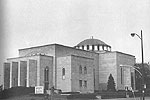|

South Lakefront
(continued)
Just when South Shore was beginning to show many signs of urban
decay, it began to stabilize and make a comeback in the 1970s.
New housing has been built along the lakefront, and plans are
under way for the revitalization of 71st Street. The Academy
of
St. James College Preparatory School, housed in a former Jewish
high school at 7550 S. Phillips Avenue, was opened in 1970 and
offers no-nonsense secondary education. A South Shore Historical
Society has also been founded. Other organizations dedicated
to making the community a bright spot on the South Side abound,
including the South Shore Commission,
the Neighborhood Institute, the Revitalization Center, and the
South Shore Open House Organization (See Fig. 1) . These
organizations, plus the fact that the area is well served by
mass transportation
and
is easily accessible by auto, make South Shore an attractive
place for Chicagoans.
But there are still problems. Drugs and crime have hurt the community.
Seventy-first and Jeffrey continues to be a problem corner. Even
the Highlands have been touched by violence. Unlike neighboring
Hyde Park with its University of Chicago, South Shore has no large
institution that has enough political influence to bring about
major improvements. The work of the South Shore Bank at 71st and
Jeffery in helping the community make a comeback has been sizable,
but problems remain. The city's economic problems have also plagued
the area, and racism has prevented investment here as it has in
other parts of the South Side.
Perhaps one lesson to be learned from South Shore is that no
community in a metropolitan area can stand alone. Those early
residents who fled Washington Park in order to leave the problems
of the city behind eventually found themselves surrounded by them.
They or their children moved again. Chicagoans have long thought
that as long as problems remain on the other side of the tracks,
there is little that can or should be done. The truth, however,
is that problems, like people, cross tracks.
«
previous
23
of 23
|
 |

|
 |


Figure 1:
Elijah Muhammad Mosque #2, 7351 S. Stony Island, 1980. »
|